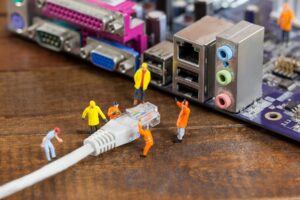LAN is a term that we may have heard often related to internet networks. But not everyone understands about LAN and how to optimize its performance? In this article we will discuss the definition of LAN and LAN Card, as well as tips for optimizing LAN.
What is LAN?
LAN stands for Local Area Network, which is a collection of multiple devices connected together in one physical location, such as the same building, office, or home. LANs can be small or large, scaling from a home network with 1 user to a large enterprise-level network with thousands of users and devices.
Whatever the size, LAN refers to a network connected to devices in a limited area. In comparison, there is also a Wide Area Network (WAN) or Metropolitan Area Network (MAN) that covers a large geographic area. Some WANs and MANs connect many LANs together.
LAN consists of cables, access points, switches, routers, and other components that allow devices to connect to internal servers. Nowadays, there are also Virtual LANs (VLANs) that allow network administrators to group network nodes and subdivide networks without the need for major infrastructure changes.
What is LAN Card?
In order to connect to a network, devices need an interface to translate information into packets of information that are transmitted to the network. If the network used is in a limited area, it is called a LAN. Well, LAN Card is a network interface that devices use in order to communicate with the network. There are LAN Cards that use cables, some are wireless.
LAN Cards are also called Network Interface Controllers (NIC). Any device that connects to a network needs a LAN Card. Be it computers, printers, game consoles, TVs, cell phones, and any network-compatible Internet of Things (IoT) device. All these devices can be connected with the right LAN Card.
Tips for Optimizing LAN Performance
In order for wireless LAN performance to be optimized. there are several tips that can be tried, namely:
1. Splitting a WLAN into VLANs
If the network used is connected to more than 512 users or devices, it is highly recommended to divide the WLAN into several VLANs. If the broadcast domain is too large, the performance will decrease and unexpected issues may arise. Activities on the network become uncomfortable if left unchecked.
If using a controller-based WLAN, it is recommended to use a feature called VLAN pooling. This is a feature that allows users to configure multiple VLANs and combine them in 1 pool. The system will then distribute the network equally to the VLANs in the pool.
If using a WLAN without a controller base, it is recommended to create different VLANs for each SSID and user. After that, divide the VLAN tasks based on their roles. So each VLAN will perform different tasks.
2. Get rid of “One-Off” Wireless Networks
One-offs are networks installed by vendors to accommodate their equipment. This could be AV control equipment that requires Wi-Fi to communicate between the remote and the controller processor. It could also be HVAC controls that use Wi-Fi to communicate with other devices, or other types of systems.
All of these different networks have the potential to create more RF congestion and ultimately degrade performance. If using an enterprise-level WLAN, then all these services can be handled without problems, without compromising the security or performance levels of the existing WLAN. As for the WLAN level below, of course it will not be able to handle this heavy work.
3. Get Rid of Ad-Hoc Networking on New Devices
If using a new device on the network, it is recommended to get rid of the ad-hoc network that has been set up by default. For example, wireless printers from HP are known to have this network. The printer can broadcast on the ad-hoc network which turns out after tracing to be using a non-standard channel, which will greatly affect the quality of our network.
4. Enforce a policy prohibiting the use of WLAN for cell phones
It turns out that cell phones are strongly discouraged from using WLAN networks. Cell phones are generally equipped with internet data packages. The reason is because cell phones can control the network on the WLAN. The cellphone turns out to consume several IPs at once, firewall licenses, and bandwidth. So if the cellphone uses the WLAN, it will interfere with the performance of other devices.
It’s not that cell phones shouldn’t use WLANs at all. If the cellphone really needs access on our network, then occasionally it’s okay. But it would be better if the cellphone just uses its cellular data service to access the internet.
5. Avoid Adding a New SSID for Every New Initiative
In a network experiment that had 8 SSIDs on its wireless network, 4 SSIDs were temporarily removed. After that, the performance improved by 45% which is a huge and meaningful improvement in internet usage. Use a wireless solution that can utilize multiple authentication methods on a single SSID to combine SSIDs with multiple tasks at once.
6. Apply Multiple Database Directory Types
If you haven’t already, try implementing some type of directory database for network users. One example is Microsoft’s directory database, which provides a big discount for server operating systems that provide Active Directory for customers. In addition, there are also many open source solutions that can be used such as Open LDAP and FreeRADIUS.
Having a directory database and using user account authentication on our network will give us insight into who is using the network. Without a directory database, all users will look the same and the authentication options available are very limited.
7. Integrate WLAN Management or Monitoring Applications on the WLAN
It is not that easy to get monitoring services on the WLAN, but if we use it, the results will be very satisfying. WLAN performance is better, because this kind of application is able to provide proactive warnings if there is a problem on the network.
Of course, network monitoring applications will always check if there is a problem with performance and provide what the solution is. Without monitoring, the reaction to problems will be very slow.
No one wants a LAN to be disrupted, especially if it is used for a corporate network that requires the internet at all times. Poor LAN performance will slow down the overall performance of employees. So how do you solve it?
Netmonk is here as a trusted network monitoring service in Indonesia. Netmonk is able to monitor the condition of network devices to ensure their performance is running optimally. Netmonk even provides a 14-day trial that can be obtained directly on its website easily!
Reference:
https://www.securedgenetworks.com/blog/7-tips-for-improving-the-performance-of-your-wireless- lan







